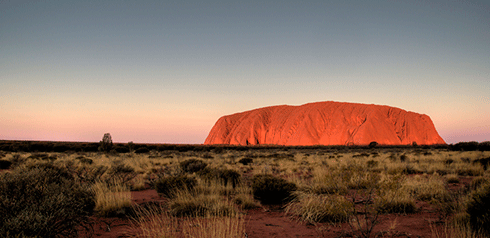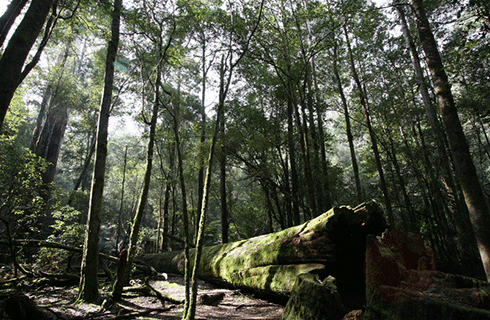
|
Published: 28 April 2014
Taking stock of the opportunities and risks with landscape carbon
Take a look at the following photos of Australian landscapes, and hazard a guess as to which stores more carbon. First, we have the dry, arid landscape of central Australia. Below that, the wet, lush forests of southern Australia.

|
|
How much carbon is stored in Australia’s landscapes? Credit:
Nathan Siemers/Flickr, CC BY-SA
|

|
|
Tasmania, typical of the lush forests of southern Australia. Credit:
NatureNut3/Flickr, CC BY-NC-ND
|
If you guessed the Tasmanian forest, you’re half right. While more dense in carbon, the forests of southern Australia represent a mere 10 per cent of Australia’s total land carbon stores.
The arid and semi-arid shrublands and woodlands of inland Australia, while sparsely vegetated, store 70 per cent of Australia’s land carbon. Much of this is underground.
Small changes to these vast stores of carbon could have a significant impact on Australia’s efforts to mitigate greenhouse gas emissions. To be certain of the positive contribution our vegetation and soils can make to emission reduction targets, we need a better grasp on present and future risks to the carbon stored in our landscape.
Sinking carbon
One of the many services Australia’s landscapes provide is their capacity to sequester and store CO2 in vegetation and organic matter in soils.
This process offsets the movement of CO2 back to the atmosphere through decomposition of organic matter and partially buffers increasing rates of anthropogenic CO2 emissions.
Recently, programs have emerged to take advantage of this service, including tree-based carbon sequestration schemes, and avoided deforestation through REDD+. These initiatives have an important role to play in not only maintaining the state of the terrestrial carbon store, but in increasing this into the future.
Forests, environmental plantings (e.g. for managing carbon, salinity, biodiversity and amenity), and plantations are typically long-lived and amenable to management. Thus, they will form an important component of our mitigation strategies.
Climate risk
Ironically, climate change poses a significant risk to these helpful pools of carbon.
The latest State of the Climate report from CSIRO shows mean annual temperature has risen 0.9°C since 1910. Rainfall distribution has shifted, and there has been a worrying increase in fire weather since the 1970s.
These changes don’t just affect our homes and communities, they also impact our ecosystems, and the benefits those ecosystems offer.
Given how important they are, there has been very little research on the risks that changing climates pose to these carbon sinks. There is considerable uncertainty about the ongoing capacity of these sinks, and associated feedbacks to climate systems.
For example, in Australia, fire is often considered to be the most significant risk to the carbon stored in forests. Under the warming and drying trends observed in Australia’s temperate regions, the risk of fires to these carbon stores is expected to increase.
But extreme droughts and heatwave events can also drive significant forest death events. The potential for increases in the frequency and intensity of drought under climate change might be expected to drive long-term vegetation changes, thinning forests and reducing their productivity and carbon storage capacity.
What we expect isn’t always what we see
Significant tree deaths followed rainfall declines in south west Western Australia. But we are yet to understand if these sorts of stochastic events will lead to long term declines in forest productivity wherever there is warming and drying.
And while southern Australia has been getting warmer and drier, much of northern and central Australia appears to be getting wetter. Indeed one recent study suggests that productivity across Australia as a whole could increase if these continental scale trends continue.
But CO2 doesn’t just alter the climate. It is now well known that vegetation is more productive (that is, captures more CO2) under higher concentrations. Plants use water and sunlight (key ingredients for photosynthesis) more efficiently when there is more CO2. This CO2 ‘fertilisation’ has led to 11 per cent more green cover across the globe’s drier environments over the past three decades.
How much can CO2 fertilisation counter warming and drying in already dry environments? And for how long will forests continue to respond to CO2 fertilisation?
Before we hail CO2 fertilisation as a saving grace, we need to come back to the issue of fire. In southern Australia, any CO2-driven increases in productivity and biomass will most likely also mean higher fuel loads. This, along with warming and drying, is likely to substantially change fire patterns.
Counting the whole continent
Despite uncertainty about future climatic conditions and how vegetation will respond, investment continues without an understanding of the risks to these. Any benefit of planting trees to sequester carbon may be in vain if the carbon in them, or in the forests next to them, goes up in smoke or withers under drought or heatwaves.
Instead, we need a strategy that looks beyond forests to the whole continent, including arid and semi-arid landscapes, which might be amenable to management through manipulating fire regimes.
Once we understand more about the risks to carbon stores in response to climate change, we can be more certain of the prospect of land-based mitigation.
Dr Anthony O’Grady, Dr Michael Battaglia, Dr Randall Donohue and Dr Stephen Roxburgh are researchers at the CSIRO. This article was originally published in The Conversation.



